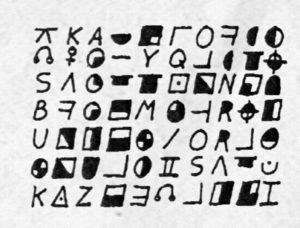I’ve blogged a few times about trying to crack the Scorpion Ciphers (a series of apparently homophonic ciphers sent to American crime TV host John Walsh). Most of my effort has been spent on the Scorpion S5 cipher, which (despite having 12 columns) appears to be rigidly cycling between 16 cipher alphabets.
However, it struck me a few days ago that this might also give us a way in to the Scorpion S1 cipher. This is because all the repeats there seem to be at a column distance of 0, 1, 4, 5, and 6, with the overwhelming majority of repeats at column distances 0 and 5. (The only exception is the “backwards L” glyph, which appears in two pairs, one pair at column distance 0 apart other, and the other at column distance 5 apart)
The Slippy S1 Five-Alphabet Hypothesis
Putting the 16-alphabet-cycle from S5 together with the mostly-0-or-5-column-distance observation from S1 yields my “Slippy S1 Five-Alphabet Hypothesis”: that Scorpion S1 was constructed from a cycle of 5 cipher alphabets, where the encipherer always reset to alphabet #1 at the beginning of a line, and usually (but not always) stepped to the next alphabet along with each new column.
So whereas a rigid 5-alphabet cycle (i.e. with no slips) would have a fixed alphabet “ownership” of 1234512345 for each ten-glyph line, I suspect that we can make a “slippy” guess for S1’s cycle ownership, to try to reconstruct where the encipherer slipped from one cycle into the next. My best current set of guesses for S1 is therefore:
1234512235
1234512344
1234412345
1234512345
1234112345
1234551245
2234512345
(Note that I suspect that the “backwards L” shape appears on two alphabets, i.e. once in alphabet #2 and once in alphabet #4, but that this is the only exception to the rule.)
What this means is that each of the five alphabets has only 26 glyphs in them (one for each letter of the alphabet): and so we can tell that if two shapes are numbered as being in the same alphabet, they are very probably two different letters.
Can We Solve This?
53 of S1’s 10 x 7 = 70 glyphs are unique, yielding a high multiplicity of 75.7%. By way of comparison, it would seem that normal (unstructured) homophonic ciphers are only solvable when their multiplicity is around the 20%-25% mark.
However, the question here is whether being able to group the letters into five unique alphabets (even probabilistically) reduces the number of combinations enough to make this genuinely solvable. As normal, pencil-and-paper solvers can make some pretty good guesses, e.g. the “S Λ” pair on lines #3 and #6 probably enciphers “TH”, while any repeated letter stands a good chance of being a normal high-frequency letter such as ETAOINS etc: but computers would do this much better.
My instinct is that this should be a good candidate for hill-climbing: and that the one-glyph-per-letter-per-alphabet constraint will prove reasonably effective. But effective enough? We’ll have to wait and see…
Incidentally, a good sanity check for this Scorpion S1 hypothesis would be to run some “forward simulations” (which is the kind of thing Dave Oranchak has done so much of with the Zodiac Killer Ciphers). By which I mean: if we feed a variety of 70-letter English texts into my best guess set of slippy cycles (i.e. “ITWASTHEBESTOFTIMESI” fed into 1234512235 / 1234512344 would become: “I1 T2 W3 A4 S5 T1 H2 E2 B3 E5 S1 T2 O3 F4 T5 I1 M2 E3 S4 I4”), I predict that the final average multiplicity of the texts will be close to 75%. But I might be wrong!
